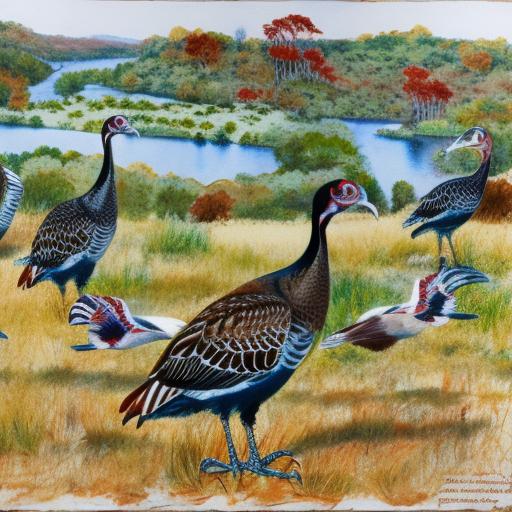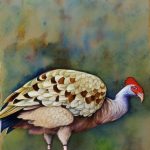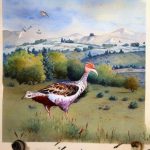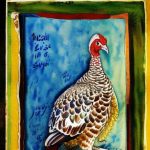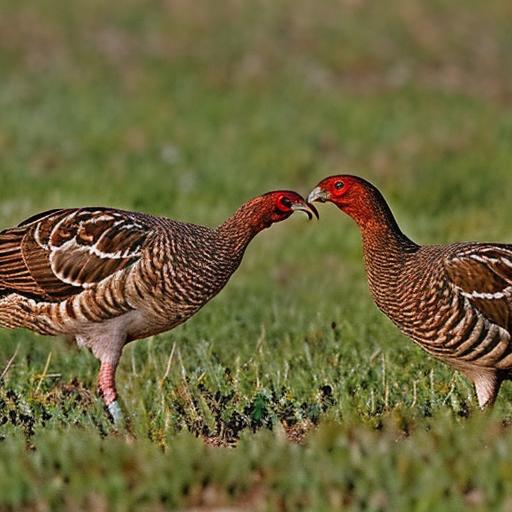Wild turkeys are an iconic symbol of American wildlife, with their distinctive plumage and impressive size. These birds are native to North America and have been an important part of the continent’s ecosystem for thousands of years. They are known for their elusive nature and keen senses, making them a popular game animal for hunters. Wild turkeys are also a common sight in rural and suburban areas, where they can often be seen foraging for food in fields and woodlands.
The history of wild turkeys in America is a fascinating one. These birds were once widespread across the continent, but their populations declined dramatically in the 19th and early 20th centuries due to habitat loss and overhunting. Thanks to conservation efforts and reintroduction programs, wild turkey populations have rebounded in many areas, and they are now found in nearly every state in the U.S. There are several different breeds of wild turkeys, each with its own unique characteristics and habitat preferences. In this article, we will explore the various breeds of wild turkeys found in America, including the Eastern, Osceola, Rio Grande, Merriam’s, and Gould’s breeds, as well as hybrid breeds that have resulted from interbreeding between different wild turkey populations.
Key Takeaways
- Wild turkeys are native to North America and are found in various regions across the continent.
- The Eastern wild turkey breed is the most widespread and populous breed, found in the eastern United States and parts of Canada.
- The Osceola wild turkey breed is found in Florida and is known for its smaller size and darker plumage.
- The Rio Grande wild turkey breed is found in the southwestern United States and northern Mexico, known for its lighter plumage and adaptability to different habitats.
- The Merriam’s wild turkey breed is found in the mountainous regions of the western United States and is known for its white-tipped tail feathers and preference for higher elevations.
The Eastern Wild Turkey Breed
The Eastern wild turkey (Meleagris gallopavo silvestris) is the most widespread and populous breed of wild turkey in North America. These birds are found in the eastern United States, from Maine to Florida and west to Texas. They prefer mature forests with a mix of hardwoods and conifers, as well as open areas such as fields and meadows where they can find food. Eastern wild turkeys are known for their large size and impressive plumage, with males (known as toms) sporting iridescent feathers and long, fan-shaped tails.
Eastern wild turkeys are highly adaptable and can thrive in a variety of habitats, from dense woodlands to suburban neighborhoods. They are omnivorous, feeding on a diet of seeds, nuts, insects, and small vertebrates. During the breeding season, males display elaborate courtship behaviors, including strutting, gobbling, and puffing out their feathers to attract females. Eastern wild turkeys are an important game animal for hunters and are also valued for their role in controlling insect populations and dispersing seeds in their native habitats.
The Osceola Wild Turkey Breed
The Osceola wild turkey (Meleagris gallopavo osceola), also known as the Florida wild turkey, is a subspecies of the Eastern wild turkey that is found exclusively in the state of Florida. These birds are named after the famous Seminole chief Osceola and are known for their smaller size and darker plumage compared to other Eastern wild turkey breeds. Osceola wild turkeys prefer the dense forests and swamps of the Florida peninsula, where they can find ample food and cover.
Osceola wild turkeys are highly prized by hunters for their challenging behavior and limited range. They are known for their keen senses and elusive nature, making them a coveted trophy for those who pursue them. Conservation efforts have helped to stabilize Osceola wild turkey populations in recent years, but habitat loss and fragmentation continue to pose a threat to these birds. Efforts to protect and restore their native habitats are crucial for ensuring the long-term survival of this unique breed of wild turkey.
The Rio Grande Wild Turkey Breed
The Rio Grande wild turkey (Meleagris gallopavo intermedia) is a breed of wild turkey that is found in the central plains and southwestern United States, including Texas, Oklahoma, Kansas, and parts of New Mexico and Colorado. These birds prefer open woodlands and brushy areas near rivers and streams, where they can find food and cover. Rio Grande wild turkeys are known for their adaptability and resilience, thriving in a variety of habitats ranging from grasslands to mesquite scrublands.
Rio Grande wild turkeys are valued by hunters for their challenging behavior and impressive size. They are known for their distinctive gobbling calls and elaborate courtship displays during the breeding season. Conservation efforts have helped to stabilize Rio Grande wild turkey populations in many areas, but habitat loss and overhunting continue to pose a threat to these birds. Efforts to protect and restore their native habitats are crucial for ensuring the long-term survival of this unique breed of wild turkey.
The Merriam’s Wild Turkey Breed
The Merriam’s wild turkey (Meleagris gallopavo merriami) is a breed of wild turkey that is found in the mountainous regions of the western United States, including parts of Montana, Wyoming, South Dakota, Nebraska, and New Mexico. These birds prefer open pine forests and meadows at higher elevations, where they can find food and cover. Merriam’s wild turkeys are known for their striking white-tipped tail feathers and pale plumage, which helps them blend in with their snowy mountain habitats.
Merriam’s wild turkeys are highly adaptable and can thrive in harsh mountain environments with cold winters and limited food sources. They are valued by hunters for their challenging behavior and impressive size, as well as their stunning appearance. Conservation efforts have helped to stabilize Merriam’s wild turkey populations in many areas, but habitat loss and climate change continue to pose a threat to these birds. Efforts to protect and restore their native habitats are crucial for ensuring the long-term survival of this unique breed of wild turkey.
The Gould’s Wild Turkey Breed

The Gould’s wild turkey (Meleagris gallopavo mexicana) is a breed of wild turkey that is found in the mountainous regions of northern Mexico and the southwestern United States, including parts of Arizona and New Mexico. These birds prefer open pine forests and oak woodlands at higher elevations, where they can find food and cover. Gould’s wild turkeys are known for their impressive size and striking plumage, with males sporting iridescent feathers and long, fan-shaped tails.
Gould’s wild turkeys are highly prized by hunters for their challenging behavior and limited range. They are known for their keen senses and elusive nature, making them a coveted trophy for those who pursue them. Conservation efforts have helped to stabilize Gould’s wild turkey populations in recent years, but habitat loss and fragmentation continue to pose a threat to these birds. Efforts to protect and restore their native habitats are crucial for ensuring the long-term survival of this unique breed of wild turkey.
The Hybrid Wild Turkey Breeds
In addition to the purebred breeds of wild turkeys found in America, there are also several hybrid breeds that have resulted from interbreeding between different populations. These hybrids often exhibit a mix of characteristics from their parent breeds, making them an interesting study for wildlife biologists and conservationists. Hybrid wild turkeys can be found in areas where different breeds overlap in their ranges, such as parts of Texas where Rio Grande and Eastern wild turkeys interbreed.
Hybrid wild turkeys may exhibit a wide range of physical traits and behaviors, depending on the specific breeds involved in their parentage. Some hybrids may show a mix of plumage colors or patterns, while others may display unique courtship behaviors or vocalizations. While hybridization can introduce genetic diversity into wild turkey populations, it can also pose challenges for conservation efforts aimed at preserving purebred breeds. Understanding the dynamics of hybridization is an important aspect of managing wild turkey populations and ensuring their long-term survival.
In conclusion, the diverse breeds of wild turkeys found in America represent an important part of the continent’s natural heritage. Each breed has its own unique characteristics and habitat preferences, making them a fascinating subject for wildlife enthusiasts and conservationists alike. By understanding the biology and behavior of these birds, we can work towards protecting their native habitats and ensuring their continued presence in the American landscape for generations to come.
Did you know that there are six different breeds of wild turkeys in America? Each breed has its own unique characteristics and habitat preferences. To learn more about the mating season for turkeys and how they breed, check out this informative article on PoultryWizard. Understanding the behavior and breeding patterns of wild turkeys can provide valuable insights for anyone interested in wildlife conservation or hunting.
FAQs
How many breeds of wild turkey are in America?
There are six subspecies of wild turkey in America: Eastern, Osceola (Florida), Rio Grande, Merriam’s, Gould’s, and the South Mexican (also known as the Mexican wild turkey).
What are the characteristics of the Eastern wild turkey?
The Eastern wild turkey is the most widespread subspecies and is found in the eastern United States. It has dark, iridescent plumage and tends to be larger and heavier than other subspecies.
Where can the Osceola (Florida) wild turkey be found?
The Osceola wild turkey is found only in the state of Florida. It has dark, shiny feathers and tends to be smaller and more slender than other subspecies.
What are the distinguishing features of the Rio Grande wild turkey?
The Rio Grande wild turkey is found in the central plains states and the western United States. It has lighter, more coppery plumage and tends to have longer legs than other subspecies.
What is unique about the Merriam’s wild turkey?
The Merriam’s wild turkey is found in the mountainous regions of the western United States. It has white-tipped feathers and tends to be smaller and more colorful than other subspecies.
Where can the Gould’s wild turkey be found?
The Gould’s wild turkey is found in the mountainous regions of the southwestern United States and northern Mexico. It has a distinctive white band on its tail feathers and tends to be the largest of all the wild turkey subspecies.
What are the characteristics of the South Mexican (Mexican wild turkey)?
The South Mexican wild turkey is found in the mountainous regions of northern Mexico. It has dark, iridescent plumage and tends to be smaller and more colorful than other subspecies.
Meet Walter, the feathered-friend fanatic of Florida! Nestled in the sunshine state, Walter struts through life with his feathered companions, clucking his way to happiness. With a coop that’s fancier than a five-star hotel, he’s the Don Juan of the chicken world. When he’s not teaching his hens to do the cha-cha, you’ll find him in a heated debate with his prized rooster, Sir Clucks-a-Lot. Walter’s poultry passion is no yolk; he’s the sunny-side-up guy you never knew you needed in your flock of friends!

